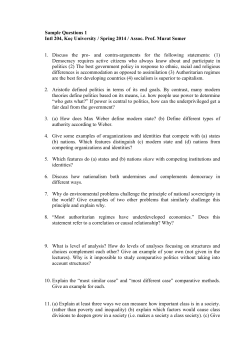
How to strengthen the territorial dimension of ‘Europe
How to strengthen the territorial dimension of ‘Europe 2020’ and EU Cohesion Policy REPORT based on the Territorial Agenda 2020 prepared at the request of the Polish Presidency of the Council of the European Union by Kai Böhme Philippe Doucet Tomasz Komornicki Jacek Zaucha Dariusz Świątek Joint Meeting of the Urban Development Group and the National Territorial Cohesion Contact Points – Agenda Warsaw July 12th 2011, SETTING THE SCENE Two „cores” ESDP Territorial Agenda 2007 Territorial Agenda 2020 Resolutions of DGs ? Lisbon Strategy Europe 2020 Strategy SETTING THE SCENE Conclusions 1. Language matters (lets speak the language that can be clear for non-believers) 2. Let’s meet on policy ground (translate the TA 2020 provisions relevant for Europe 2020 into provisions/regulations of the Cohesion Policy) 3. Discussing TA related issues make no sense any longer unless EU authorities make formal policy decisions. 4. Demonstrate added value of the territorial approach for effectiveness of the policies STARTING POINT (structure of thinking) Europe 2020 As a given, no comments!!! Focus on the headline targets TSP 2020 TA 2020 Cohesion Policy Only actions relevant for Europe 2020 Based on the 5th Cohesion Report and lessons from the past STARTING POINT Territorial Keys Accessibility Services of general economic interest Territorial capacities / endowments / assets City networking Functional regions They bridge Europe 2020 & TA2020, and show that territory matters for ‘Europe 2020’. Policy ground Territorial cohesion (TC) must impact EU policy-making •content-wise •process-wise Proposal •Official EU reference policy document •Formal Council decisions on TC •Keep TA2020 as interface between EU, national and regional policies Policy ground Cohesion Policy as an example of territorialisation of policies Regulations EU Community Strategic Framework (CSF) National Development and Investment Partnership Contract (DIPC) Operational Programmes (OP) Discuss with / consult your colleagues on the detailed proposals! Policy ground General and other Regulations: 1. Mainstream Territorial Cohesion (TC) 2. TC as ex-ante conditionality 3. Territorial keys applied when it comes to (a) content of the future NSRF (DIPC) (b) the reporting by Member States and EU, (c) the SWOT analysis of the OPs and justification of the priorities, (d) the partnership and (e) evaluations and monitoring (incl. indicators). 4. Issue-based concentration Same logic must be applied to all moments of Cohesion Policy ! Added value for policy effectiveness Territorial keys for policy making – example for National Development and Investment Partnership Contract (DIPC) STEP 1 Territorial keys SWOT for a given territorial key STEP 2 Choice of relevant linking isuses STEP 3 STEP 4 Territorial typologies Relevant policy mix Each country comes up with own proposals Territorial key: accessibility Example: Poland Conclusions Key points for action: 1. Integration of policies/ policy effectiveness ⇒ Content (issue-based concentration) ⇒ Process (vertical, horizontal & territorial integration) ⇒ Formal Council decision on EU reference document 2. Conditionality ⇒ EU regulations & CSF ⇒ National DIPC ⇒ Programme preparation & implementation 3. Cohesion Policy is only one example ⇒ Do the same of other EU and national policies The report has been produced with the assistance of the European Union. The content of this publication is the sole responsibility of the authors and can in no way be taken to reflect the views of the European Union. Thank you for your attention Policy ground Territorial Cohesion ex-ante conditionality: Stage 1: Preparation of the programming documents •Territorial dimension in programme targets and objectives, and partnership; •SWOT analysis at programme level; •Ex-ante evaluation including a territorial impact assessment. Stage 2: Submission of the programming documents •Actions needed for a territorially differentiated implementation of the ‘Europe 2020’ •Territorial approach to project generation, selection criteria, indicators, etc. Stage 3: Negotiation and agreement of commitments Stage 4: Follow up •Reporting on progress in annual implementation reports, •Particular territorial cohesion indicators (e.g. those elaborated by ESPON), •Annual territorial impact reviews, •Progress made with regard to the territorial keys.
© Copyright 2025





















